Break Even Analysis and Example: Finance Report, Semester 1
VerifiedAdded on 2020/03/16
|7
|1163
|456
Report
AI Summary
This report provides a detailed analysis of break-even analysis, a crucial concept in financial management. It begins by defining the break-even point (BEP) as the point where total costs equal total revenue, resulting in zero profit. The report outlines key assumptions underlying break-even analysis, including average sales per unit, average per-unit cost, and monthly fixed costs. It emphasizes the importance of break-even analysis in determining production levels and sales targets, while also highlighting its use in understanding a product's contribution margin. The report then presents two formulas for calculating break-even analysis, one based on dividing total fixed costs by the contribution margin per unit and another using the contribution margin ratio. A detailed example is included to illustrate these calculations, providing a clear understanding of how to determine the break-even point in units and in dollar sales. Finally, the report includes a comprehensive example of break-even analysis with a table showing how profit or loss changes with unit sales, and a list of references used.

Running head: BREAK EVEN ANALYSIS
Break even analysis
Name of the student
Name of the university
Author note
Break even analysis
Name of the student
Name of the university
Author note
Paraphrase This Document
Need a fresh take? Get an instant paraphrase of this document with our AI Paraphraser
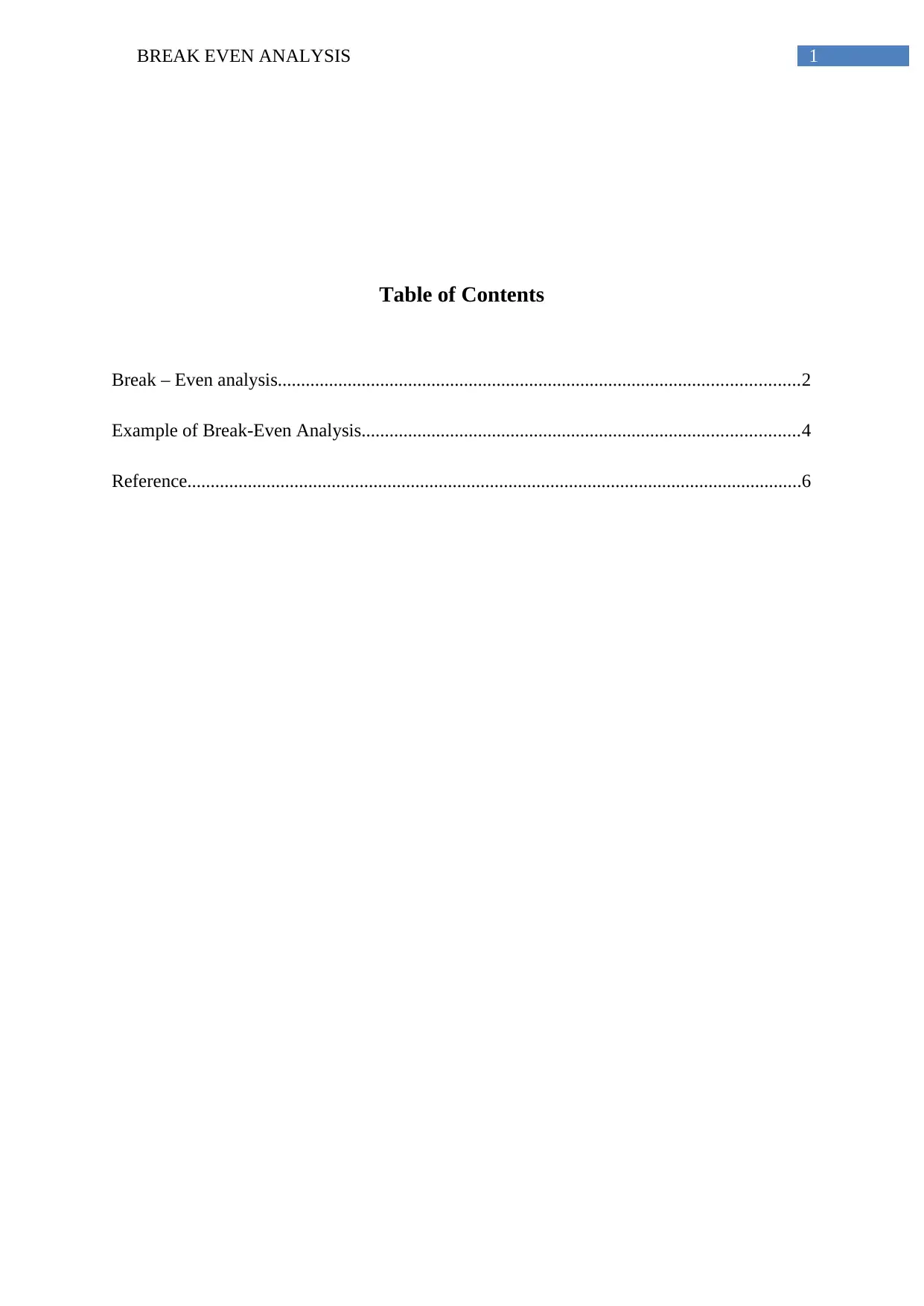
1BREAK EVEN ANALYSIS
Table of Contents
Break – Even analysis................................................................................................................2
Example of Break-Even Analysis..............................................................................................4
Reference....................................................................................................................................6
Table of Contents
Break – Even analysis................................................................................................................2
Example of Break-Even Analysis..............................................................................................4
Reference....................................................................................................................................6
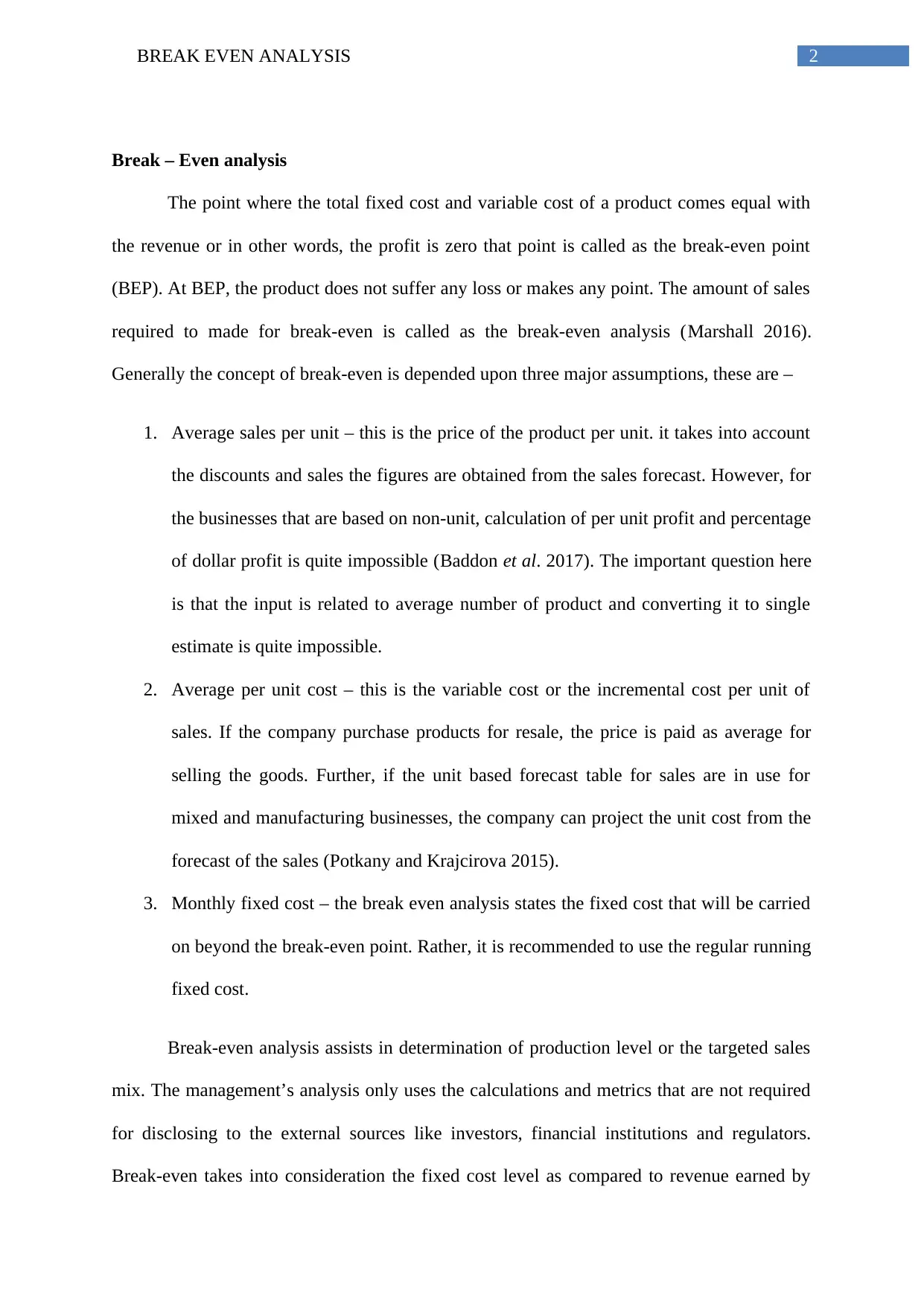
2BREAK EVEN ANALYSIS
Break – Even analysis
The point where the total fixed cost and variable cost of a product comes equal with
the revenue or in other words, the profit is zero that point is called as the break-even point
(BEP). At BEP, the product does not suffer any loss or makes any point. The amount of sales
required to made for break-even is called as the break-even analysis (Marshall 2016).
Generally the concept of break-even is depended upon three major assumptions, these are –
1. Average sales per unit – this is the price of the product per unit. it takes into account
the discounts and sales the figures are obtained from the sales forecast. However, for
the businesses that are based on non-unit, calculation of per unit profit and percentage
of dollar profit is quite impossible (Baddon et al. 2017). The important question here
is that the input is related to average number of product and converting it to single
estimate is quite impossible.
2. Average per unit cost – this is the variable cost or the incremental cost per unit of
sales. If the company purchase products for resale, the price is paid as average for
selling the goods. Further, if the unit based forecast table for sales are in use for
mixed and manufacturing businesses, the company can project the unit cost from the
forecast of the sales (Potkany and Krajcirova 2015).
3. Monthly fixed cost – the break even analysis states the fixed cost that will be carried
on beyond the break-even point. Rather, it is recommended to use the regular running
fixed cost.
Break-even analysis assists in determination of production level or the targeted sales
mix. The management’s analysis only uses the calculations and metrics that are not required
for disclosing to the external sources like investors, financial institutions and regulators.
Break-even takes into consideration the fixed cost level as compared to revenue earned by
Break – Even analysis
The point where the total fixed cost and variable cost of a product comes equal with
the revenue or in other words, the profit is zero that point is called as the break-even point
(BEP). At BEP, the product does not suffer any loss or makes any point. The amount of sales
required to made for break-even is called as the break-even analysis (Marshall 2016).
Generally the concept of break-even is depended upon three major assumptions, these are –
1. Average sales per unit – this is the price of the product per unit. it takes into account
the discounts and sales the figures are obtained from the sales forecast. However, for
the businesses that are based on non-unit, calculation of per unit profit and percentage
of dollar profit is quite impossible (Baddon et al. 2017). The important question here
is that the input is related to average number of product and converting it to single
estimate is quite impossible.
2. Average per unit cost – this is the variable cost or the incremental cost per unit of
sales. If the company purchase products for resale, the price is paid as average for
selling the goods. Further, if the unit based forecast table for sales are in use for
mixed and manufacturing businesses, the company can project the unit cost from the
forecast of the sales (Potkany and Krajcirova 2015).
3. Monthly fixed cost – the break even analysis states the fixed cost that will be carried
on beyond the break-even point. Rather, it is recommended to use the regular running
fixed cost.
Break-even analysis assists in determination of production level or the targeted sales
mix. The management’s analysis only uses the calculations and metrics that are not required
for disclosing to the external sources like investors, financial institutions and regulators.
Break-even takes into consideration the fixed cost level as compared to revenue earned by
⊘ This is a preview!⊘
Do you want full access?
Subscribe today to unlock all pages.

Trusted by 1+ million students worldwide
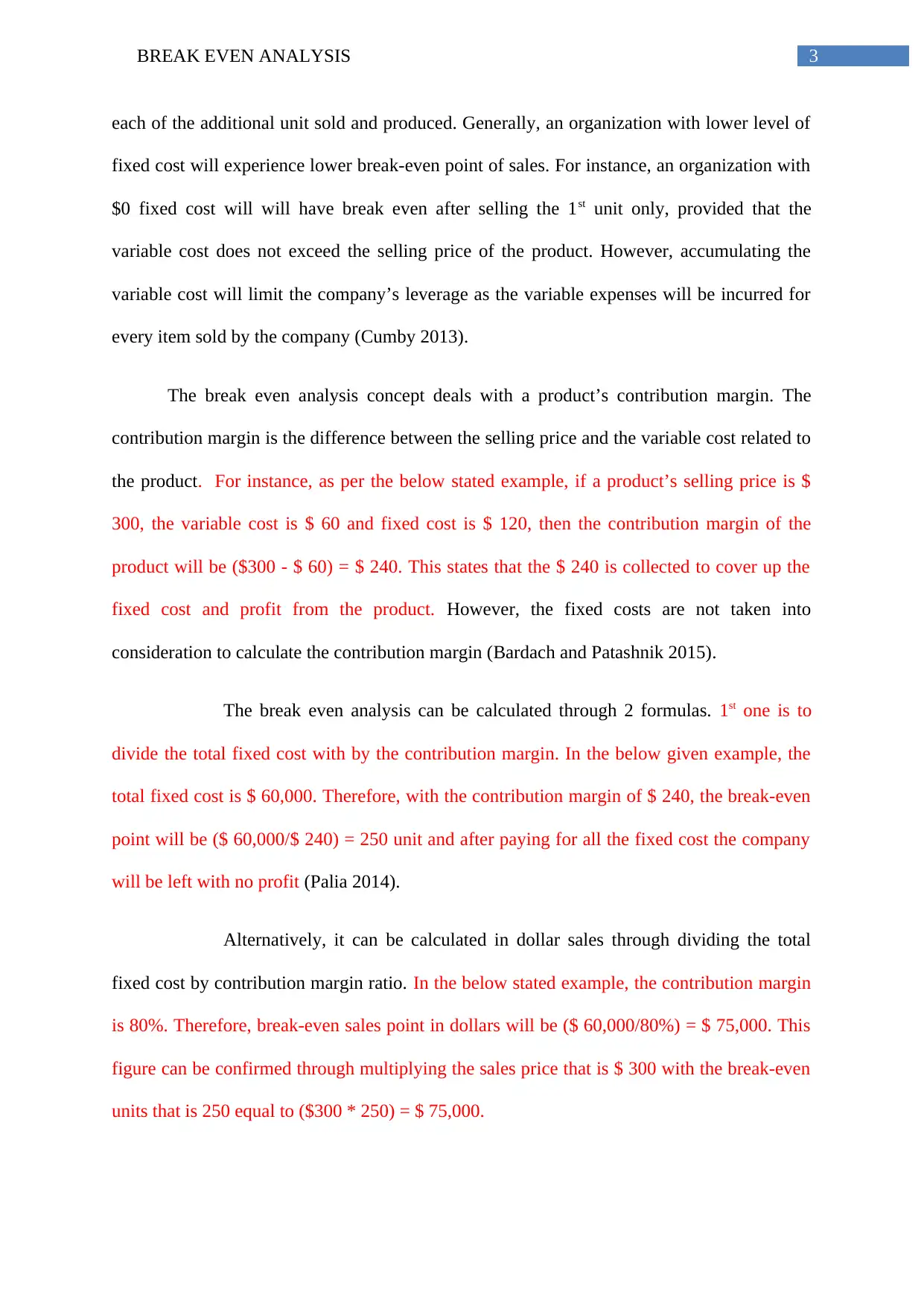
3BREAK EVEN ANALYSIS
each of the additional unit sold and produced. Generally, an organization with lower level of
fixed cost will experience lower break-even point of sales. For instance, an organization with
$0 fixed cost will will have break even after selling the 1st unit only, provided that the
variable cost does not exceed the selling price of the product. However, accumulating the
variable cost will limit the company’s leverage as the variable expenses will be incurred for
every item sold by the company (Cumby 2013).
The break even analysis concept deals with a product’s contribution margin. The
contribution margin is the difference between the selling price and the variable cost related to
the product. For instance, as per the below stated example, if a product’s selling price is $
300, the variable cost is $ 60 and fixed cost is $ 120, then the contribution margin of the
product will be ($300 - $ 60) = $ 240. This states that the $ 240 is collected to cover up the
fixed cost and profit from the product. However, the fixed costs are not taken into
consideration to calculate the contribution margin (Bardach and Patashnik 2015).
The break even analysis can be calculated through 2 formulas. 1st one is to
divide the total fixed cost with by the contribution margin. In the below given example, the
total fixed cost is $ 60,000. Therefore, with the contribution margin of $ 240, the break-even
point will be ($ 60,000/$ 240) = 250 unit and after paying for all the fixed cost the company
will be left with no profit (Palia 2014).
Alternatively, it can be calculated in dollar sales through dividing the total
fixed cost by contribution margin ratio. In the below stated example, the contribution margin
is 80%. Therefore, break-even sales point in dollars will be ($ 60,000/80%) = $ 75,000. This
figure can be confirmed through multiplying the sales price that is $ 300 with the break-even
units that is 250 equal to ($300 * 250) = $ 75,000.
each of the additional unit sold and produced. Generally, an organization with lower level of
fixed cost will experience lower break-even point of sales. For instance, an organization with
$0 fixed cost will will have break even after selling the 1st unit only, provided that the
variable cost does not exceed the selling price of the product. However, accumulating the
variable cost will limit the company’s leverage as the variable expenses will be incurred for
every item sold by the company (Cumby 2013).
The break even analysis concept deals with a product’s contribution margin. The
contribution margin is the difference between the selling price and the variable cost related to
the product. For instance, as per the below stated example, if a product’s selling price is $
300, the variable cost is $ 60 and fixed cost is $ 120, then the contribution margin of the
product will be ($300 - $ 60) = $ 240. This states that the $ 240 is collected to cover up the
fixed cost and profit from the product. However, the fixed costs are not taken into
consideration to calculate the contribution margin (Bardach and Patashnik 2015).
The break even analysis can be calculated through 2 formulas. 1st one is to
divide the total fixed cost with by the contribution margin. In the below given example, the
total fixed cost is $ 60,000. Therefore, with the contribution margin of $ 240, the break-even
point will be ($ 60,000/$ 240) = 250 unit and after paying for all the fixed cost the company
will be left with no profit (Palia 2014).
Alternatively, it can be calculated in dollar sales through dividing the total
fixed cost by contribution margin ratio. In the below stated example, the contribution margin
is 80%. Therefore, break-even sales point in dollars will be ($ 60,000/80%) = $ 75,000. This
figure can be confirmed through multiplying the sales price that is $ 300 with the break-even
units that is 250 equal to ($300 * 250) = $ 75,000.
Paraphrase This Document
Need a fresh take? Get an instant paraphrase of this document with our AI Paraphraser
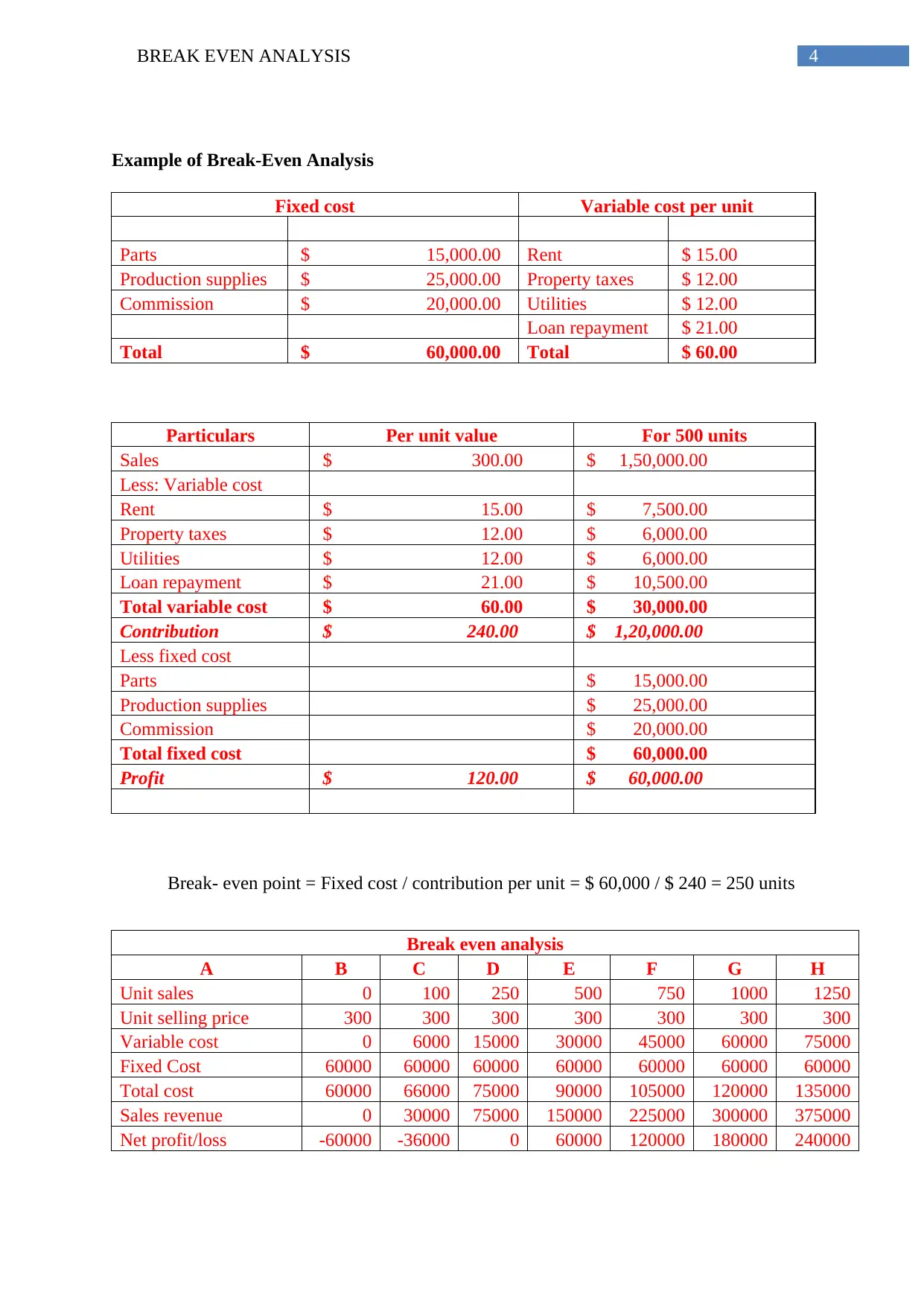
4BREAK EVEN ANALYSIS
Example of Break-Even Analysis
Fixed cost Variable cost per unit
Parts $ 15,000.00 Rent $ 15.00
Production supplies $ 25,000.00 Property taxes $ 12.00
Commission $ 20,000.00 Utilities $ 12.00
Loan repayment $ 21.00
Total $ 60,000.00 Total $ 60.00
Particulars Per unit value For 500 units
Sales $ 300.00 $ 1,50,000.00
Less: Variable cost
Rent $ 15.00 $ 7,500.00
Property taxes $ 12.00 $ 6,000.00
Utilities $ 12.00 $ 6,000.00
Loan repayment $ 21.00 $ 10,500.00
Total variable cost $ 60.00 $ 30,000.00
Contribution $ 240.00 $ 1,20,000.00
Less fixed cost
Parts $ 15,000.00
Production supplies $ 25,000.00
Commission $ 20,000.00
Total fixed cost $ 60,000.00
Profit $ 120.00 $ 60,000.00
Break- even point = Fixed cost / contribution per unit = $ 60,000 / $ 240 = 250 units
Break even analysis
A B C D E F G H
Unit sales 0 100 250 500 750 1000 1250
Unit selling price 300 300 300 300 300 300 300
Variable cost 0 6000 15000 30000 45000 60000 75000
Fixed Cost 60000 60000 60000 60000 60000 60000 60000
Total cost 60000 66000 75000 90000 105000 120000 135000
Sales revenue 0 30000 75000 150000 225000 300000 375000
Net profit/loss -60000 -36000 0 60000 120000 180000 240000
Example of Break-Even Analysis
Fixed cost Variable cost per unit
Parts $ 15,000.00 Rent $ 15.00
Production supplies $ 25,000.00 Property taxes $ 12.00
Commission $ 20,000.00 Utilities $ 12.00
Loan repayment $ 21.00
Total $ 60,000.00 Total $ 60.00
Particulars Per unit value For 500 units
Sales $ 300.00 $ 1,50,000.00
Less: Variable cost
Rent $ 15.00 $ 7,500.00
Property taxes $ 12.00 $ 6,000.00
Utilities $ 12.00 $ 6,000.00
Loan repayment $ 21.00 $ 10,500.00
Total variable cost $ 60.00 $ 30,000.00
Contribution $ 240.00 $ 1,20,000.00
Less fixed cost
Parts $ 15,000.00
Production supplies $ 25,000.00
Commission $ 20,000.00
Total fixed cost $ 60,000.00
Profit $ 120.00 $ 60,000.00
Break- even point = Fixed cost / contribution per unit = $ 60,000 / $ 240 = 250 units
Break even analysis
A B C D E F G H
Unit sales 0 100 250 500 750 1000 1250
Unit selling price 300 300 300 300 300 300 300
Variable cost 0 6000 15000 30000 45000 60000 75000
Fixed Cost 60000 60000 60000 60000 60000 60000 60000
Total cost 60000 66000 75000 90000 105000 120000 135000
Sales revenue 0 30000 75000 150000 225000 300000 375000
Net profit/loss -60000 -36000 0 60000 120000 180000 240000
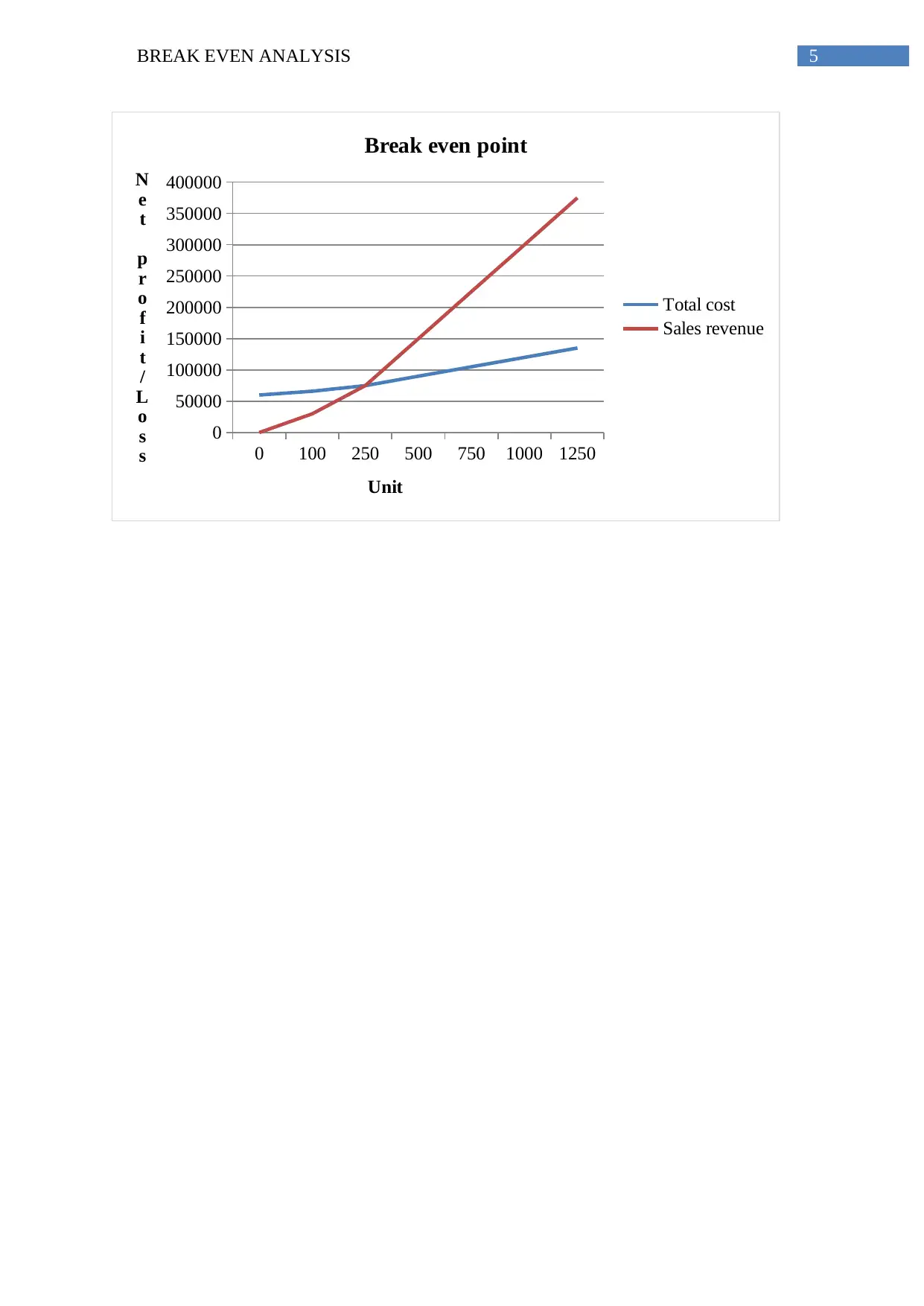
5BREAK EVEN ANALYSIS
0 100 250 500 750 1000 1250
0
50000
100000
150000
200000
250000
300000
350000
400000
Break even point
Total cost
Sales revenue
Unit
N
e
t
p
r
o
f
i
t
/
L
o
s
s
0 100 250 500 750 1000 1250
0
50000
100000
150000
200000
250000
300000
350000
400000
Break even point
Total cost
Sales revenue
Unit
N
e
t
p
r
o
f
i
t
/
L
o
s
s
⊘ This is a preview!⊘
Do you want full access?
Subscribe today to unlock all pages.

Trusted by 1+ million students worldwide
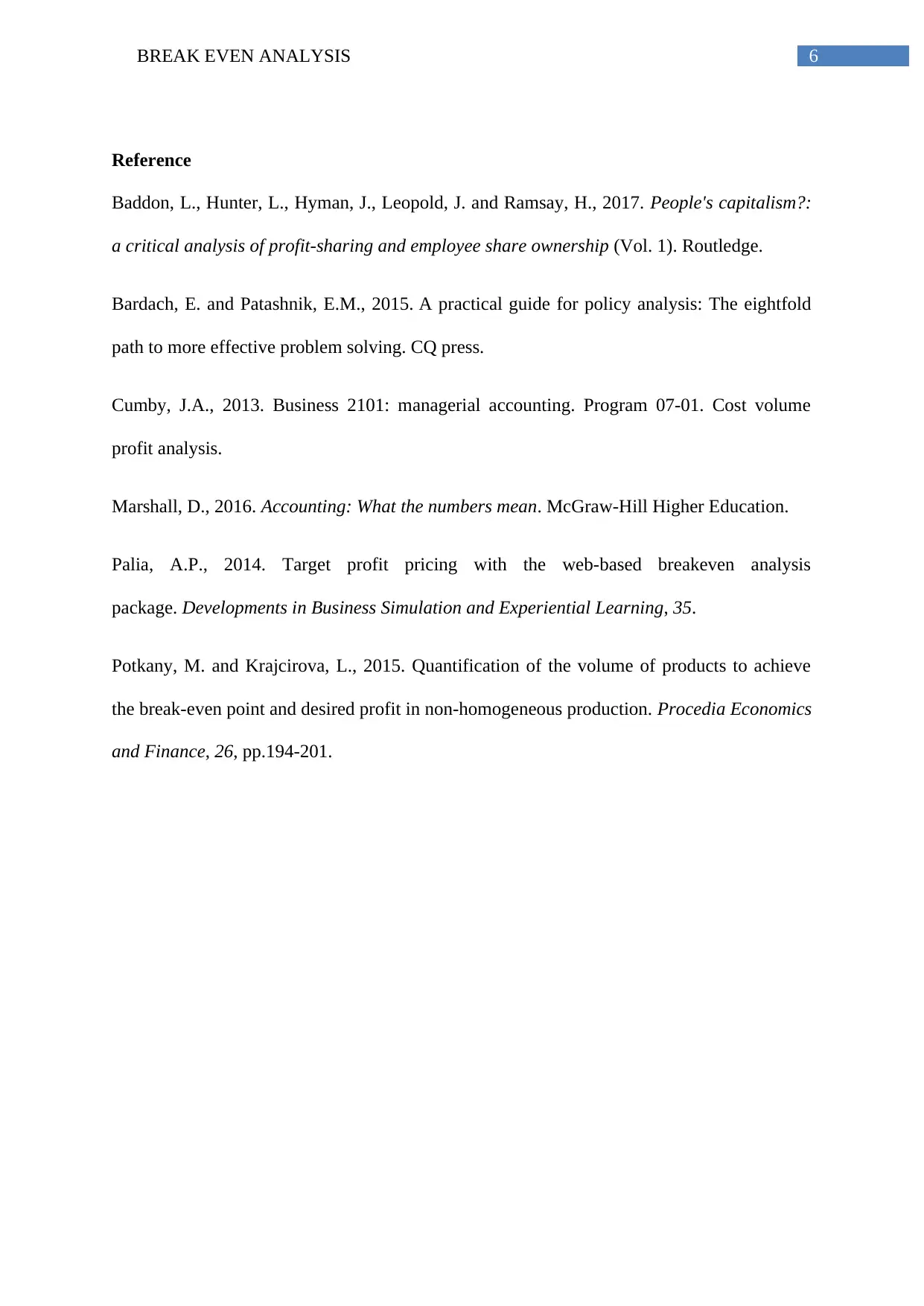
6BREAK EVEN ANALYSIS
Reference
Baddon, L., Hunter, L., Hyman, J., Leopold, J. and Ramsay, H., 2017. People's capitalism?:
a critical analysis of profit-sharing and employee share ownership (Vol. 1). Routledge.
Bardach, E. and Patashnik, E.M., 2015. A practical guide for policy analysis: The eightfold
path to more effective problem solving. CQ press.
Cumby, J.A., 2013. Business 2101: managerial accounting. Program 07-01. Cost volume
profit analysis.
Marshall, D., 2016. Accounting: What the numbers mean. McGraw-Hill Higher Education.
Palia, A.P., 2014. Target profit pricing with the web-based breakeven analysis
package. Developments in Business Simulation and Experiential Learning, 35.
Potkany, M. and Krajcirova, L., 2015. Quantification of the volume of products to achieve
the break-even point and desired profit in non-homogeneous production. Procedia Economics
and Finance, 26, pp.194-201.
Reference
Baddon, L., Hunter, L., Hyman, J., Leopold, J. and Ramsay, H., 2017. People's capitalism?:
a critical analysis of profit-sharing and employee share ownership (Vol. 1). Routledge.
Bardach, E. and Patashnik, E.M., 2015. A practical guide for policy analysis: The eightfold
path to more effective problem solving. CQ press.
Cumby, J.A., 2013. Business 2101: managerial accounting. Program 07-01. Cost volume
profit analysis.
Marshall, D., 2016. Accounting: What the numbers mean. McGraw-Hill Higher Education.
Palia, A.P., 2014. Target profit pricing with the web-based breakeven analysis
package. Developments in Business Simulation and Experiential Learning, 35.
Potkany, M. and Krajcirova, L., 2015. Quantification of the volume of products to achieve
the break-even point and desired profit in non-homogeneous production. Procedia Economics
and Finance, 26, pp.194-201.
1 out of 7
Related Documents
Your All-in-One AI-Powered Toolkit for Academic Success.
+13062052269
info@desklib.com
Available 24*7 on WhatsApp / Email
![[object Object]](/_next/static/media/star-bottom.7253800d.svg)
Unlock your academic potential
Copyright © 2020–2025 A2Z Services. All Rights Reserved. Developed and managed by ZUCOL.





